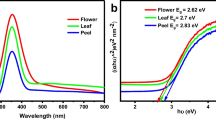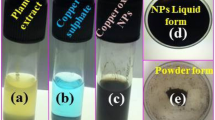Abstract
A method of green chemistry approach to synthesize copper oxide nanoparticles (CuONPs) was reported using extracts from the root, stem, and leaves of the Macleaya cordata (Wild.) R.BR as reducing and stabilizing agents. Copper acetate precursor (Cu(CH3COO)2) was used for green synthesis of copper oxide nanoparticles through reduction and oxidation reactions. The synthesized CuONPs were characterized using UV-Vis, XRD, FTIR, SEM, TEM, zeta potential, and energy-dispersive X-ray spectroscopy (EDS). The results of these analyses provided valuable insights into the structure, shape, functional groups, and elemental composition of the synthesized CuONPs. The antibacterial activity of the green synthesized CuONPs was evaluated using an agar diffusion assay. The result shows that the inhibition effect was concentration-dependent, and at the highest concentration (5 mg/mL), the CuONPs exhibited strong antibacterial activity against Escherichia coli and Staphylococcus aureus, with inhibition zones of 21 mm and 23 mm, respectively. The photocatalytic degradation of methylene blue (MB) at a concentration of 10 mg/mL by CuONPs (10 mg/mL) was evaluated using a photochemical reaction apparatus under simulated natural light. The degradation rate was found to be 65% within 3 h and 93% after 24 h. The degradation rate of higher concentrations of MB (100 mg/mL) was 47.9%. These results indicate that the synthesized CuONPs have great potential for rapidly breaking down textile dyes and exhibit exceptional antibacterial properties. This suggests that these nanoparticles could play a significant role in the development of sustainable nanotechnology.










Similar content being viewed by others
Data availability
The data that support the findings of this study are available from the corresponding author upon reasonable request.
References
Naseer H et al (2023) Investigation of Mg doped ZnO nanoparticles decorated with Ag for efficient photocatalytic degradation. J Inorg Organomet Polym Mater. https://doi.org/10.1007/s10904-023-02722-9
Maryam I et al (2023) Synthesis and characterization of Ta-doped WO3 nanomaterials for their application as an efficient photocatalyst. J Inorg Organomet Polym Mater. https://doi.org/10.1007/s10904-023-02776-9
Vindhya PS, Kavitha VT (2023) Effect of cobalt doping on antimicrobial, antioxidant and photocatalytic activities of CuO nanoparticles. Mater Sci Eng B 289. https://doi.org/10.1016/j.mseb.2022.116258
Naseer H, Iqbal T (2023) Green synthesis of silver-doped zinc oxide nanoparticles for investigation of their photocatalytic activity and shelf life applications. Biomass Convers Biorefin. https://doi.org/10.1007/s13399-023-04380-w
Velsankar K et al (2021) Ecofriendly green synthesis, characterization and biomedical applications of CuO nanoparticles synthesized using leaf extract of Capsicum frutescens. J Environ Chem Eng 9(5):106299. https://doi.org/10.1016/j.jece.2021.106299
Rajeswari VD et al (2021) Green and ecofriendly synthesis of cobalt oxide nanoparticles using Phoenix dactylifera L: antimicrobial and photocatalytic activity. Appl Nanosci 13(2):1367–1375. https://doi.org/10.1007/s13204-021-02038-5
Vetrimani A et al (2022) Effect of the green synthesis of CuO plate-like nanoparticles on their photodegradation and antibacterial activities. Phys Chem Chem Phys 24(47):28923–28933. https://doi.org/10.1039/d2cp03531f
Sharmila G et al (2018) Biogenic synthesis of CuO nanoparticles using Bauhinia tomentosa leaves extract: characterization and its antibacterial application. J Mol Struct 1165:288–292. https://doi.org/10.1016/j.molstruc.2018.04.011
Dadi R et al (2019) Antibacterial activity of ZnO and CuO nanoparticles against gram positive and gram negative strains. Mater Sci Eng C 104:109968. https://doi.org/10.1016/j.msec.2019.109968
Rahman A et al (2021) Zinc oxide and zinc oxide-based nanostructures: biogenic and phytogenic synthesis, properties and applications. Bioprocess Biosyst Eng 44(7):1333–1372. https://doi.org/10.1007/s00449-021-02530-w
Katwal R et al (2015) Electrochemical synthesized copper oxide nanoparticles for enhanced photocatalytic and antimicrobial activity. J Ind Eng Chem 31:173–184. https://doi.org/10.1016/j.jiec.2015.06.021
Outokesh M et al (2011) Hydrothermal synthesis of CuO nanoparticles: study on effects of operational conditions on yield, purity, and size of the nanoparticles. Ind Eng Chem Res 50(6):3540–3554. https://doi.org/10.1021/ie1017089
Sagadevan S et al (2017) Fabrication of CuO nanoparticles for structural, optical and dielectric analysis using chemical precipitation method. J Mater Sci: Mater Electron 28(17):12591–12597. https://doi.org/10.1007/s10854-017-7083-3
Sathiyavimal S et al (2022) Green synthesis of copper oxide nanoparticles using Abutilon indicum leaves extract and their evaluation of antibacterial, anticancer in human A549 lung and MDA-MB-231 breast cancer cells. Food Chem Toxicol 168:113330. https://doi.org/10.1016/j.fct.2022.113330
Obaid MA et al (2021). Biosynthesis of CuO NPs and its anticancer activity on human colon cancer cell lines (HT-29). J Phys: Conf Ser 1963(1). https://doi.org/10.1088/1742-6596/1963/1/012151
Kashid Y et al (2022) Bio-inspired sustainable synthesis of silver chloride nanoparticles and their prominent applications. J Indian Chem Soc 99(5). https://doi.org/10.1016/j.jics.2021.100335
Kumari S et al (2023) Biogenic approach for synthesis of nanoparticles via plants for biomedical applications: a review. Mater Today Proc. https://doi.org/10.1016/j.matpr.2023.04.242
Ghotekar S et al (2021) Environmentally friendly synthesis of Cr2O3 nanoparticles: characterization, applications and future perspective ─ a review. Case Stud Chem Environ Eng 3. https://doi.org/10.1016/j.cscee.2021.100089
Dutta V et al (2022) Bio-inspired synthesis of carbon-based nanomaterials and their potential environmental applications: a state-of-the-art review. Inorganics 10(10). https://doi.org/10.3390/inorganics10100169
Pansambal S et al (2022) Bioengineered cerium oxide (CeO2) nanoparticles and their diverse applications: a review. Appl Nanosci. https://doi.org/10.1007/s13204-022-02574-8
Nasrollahzadeh M et al (2015) Tamarix gallica leaf extract mediated novel route for green synthesis of CuO nanoparticles and their application for N-arylation of nitrogen-containing heterocycles under ligand-free conditions. RSC Adv 5(51):40628–40635. https://doi.org/10.1039/c5ra04012d
Nagore P et al (2021) Structural properties and antimicrobial activities of polyalthia longifolia leaf extract-mediated CuO nanoparticles. BioNanoScience 11(2):579–589. https://doi.org/10.1007/s12668-021-00851-4
Dabhane H et al (2023) A novel approach toward the bio-inspired synthesis of CuO nanoparticles for phenol degradation and antimicrobial applications. Biomass Convers Biorefin. https://doi.org/10.1007/s13399-023-03954-y
Venkatesh K et al (2021) A novel hybrid construction of MnMoO4 nanorods anchored graphene nanosheets; an efficient electrocatalyst for the picomolar detection of ecological pollutant ornidazole in water and urine samples. Chemosphere 273:129665. https://doi.org/10.1016/j.chemosphere.2021.129665
ur Rehman K et al (2022) Facile synthesis of copper oxide nanoparticles (CuONPs) using green method to promote photocatalytic and biocidal applications. J Mol Liq 360:119453. https://doi.org/10.1016/j.molliq.2022.119453
Ma G et al (2023) Heterojunctioned CuO/Cu2O catalyst for highly efficient ozone removal. J Environ Sci 125:340–348. https://doi.org/10.1016/j.jes.2022.01.032
Cuong HN et al (2022) New frontiers in the plant extract mediated biosynthesis of copper oxide (CuO) nanoparticles and their potential applications: a review. Environ Res 203:111858. https://doi.org/10.1016/j.envres.2021.111858
Shinde S et al (2023) Bio-inspired synthesis and characterizations of groundnut shells-mediated Cu/CuO/Cu2O nanoparticles for anticancer, antioxidant, and DNA damage activities. J Sol-Gel Sci Technol 106(3):737–747. https://doi.org/10.1007/s10971-023-06109-7
Chauhan A et al (2022) Fabrication of copper oxide nanoparticles via microwave and green approaches and their antimicrobial potential. Chem Pap 76(11):7147–7162. https://doi.org/10.1007/s11696-022-02407-6
Dhatwalia J et al (2022) Rubus ellipticus fruits extract-mediated cuprous oxide nanoparticles: in vitro antioxidant, antimicrobial, and toxicity study. Chem Pap 77(3):1377–1393. https://doi.org/10.1007/s11696-022-02551-z
Koutavarapu R et al (2021) Recent progress in transition metal oxide/sulfide quantum dots-based nanocomposites for the removal of toxic organic pollutants. Chemosphere 272:129849. https://doi.org/10.1016/j.chemosphere.2021.129849
Jillani S et al (2018) Synthesis, characterization and biological studies of copper oxide nanostructures. Mater Res Express 5(4):045006. https://doi.org/10.1088/2053-1591/aab864
Vinothkanna A et al (2023) Biosynthesis of copper oxide nanoparticles using Rubia cordifolia bark extract: characterization, antibacterial, antioxidant, larvicidal and photocatalytic activities. Environ Sci Pollut Res Int 30(15):42563–42574. https://doi.org/10.1007/s11356-022-18996-4
ur Rehman K et al (2022) Facile synthesis of copper oxide nanoparticles (CuONPs) using green method to promote photocatalytic and biocidal applications. J Mol Liq 360. https://doi.org/10.1016/j.molliq.2022.119453
Velsankar K et al (2020) Green synthesis of CuO nanoparticles via Allium sativum extract and its characterizations on antimicrobial, antioxidant, antilarvicidal activities. J Environ Chem Eng 8(5). https://doi.org/10.1016/j.jece.2020.104123
Guo L et al (2022) Assessment of the antidiarrheal activity and chemical composition of dichloromethane extract from Macleaya cordata. Rev Bras 32(6):1009–1020. https://doi.org/10.1007/s43450-022-00337-8
Gu Y et al (2023) Antibacterial activity and mechanism of sanguinarine against Staphylococcus aureus by interfering with the permeability of the cell wall and membrane and inducing bacterial ROS production. Front Vet Sci 10. https://doi.org/10.3389/fvets.2023.1121082
Wang M et al (2022) Effects of dietary Macleaya cordata extract on growth performance, biochemical indices, and intestinal microbiota of yellow-feathered broilers subjected to chronic heat stress. Animals 12(17):2076–2615. https://doi.org/10.3390/ani12172197
Chandraker SK et al (2020) Green synthesis of copper nanoparticles using leaf extract of Ageratum houstonianum Mill. and study of their photocatalytic and antibacterial activities. Nano Express 1(1):010033. https://doi.org/10.1088/2632-959X/ab8e99
Kouhkan M et al (2020) Biosynthesis of copper oxide nanoparticles using Lactobacillus casei subsp. casei and its anticancer and antibacterial activities. Curr Nanosci 16(1):101–111. https://doi.org/10.2174/1573413715666190318155801
Bhavyasree PG, Xavier TS (2020) Green synthesis of copper oxide/carbon nanocomposites using the leaf extract of Adhatoda vasica Nees, their characterization and antimicrobial activity. Heliyon 6(2):e03323. https://doi.org/10.1016/j.heliyon.2020.e03323
Kalaiyan G et al (2020) Green synthesis of CuO nanostructures with bactericidal activities using Simarouba glauca leaf extract. Chem Phys Lett 761. https://doi.org/10.1016/j.cplett.2020.138062
Gopinath V et al (2016) In vitro toxicity, apoptosis and antimicrobial effects of phyto-mediated copper oxide nanoparticles. RSC Adv 6(112):110986–110995. https://doi.org/10.1039/c6ra13871c
Velsankar K et al (2022) Green synthesis and characterization of CuO nanoparticles using Panicum sumatrense grains extract for biological applications. Appl Nanosci 12(6):1993–2021. https://doi.org/10.1007/s13204-022-02441-6
Govindasamy GA et al (2022) Giant milkweed plant-based copper oxide nanoparticles for wound dressing application: physicochemical, bactericidal and cytocompatibility profiles. Chem Pap 77(2):1181–1200. https://doi.org/10.1007/s11696-022-02513-5
Kumar M et al (2023) Green synthesis of copper nanoparticles from Nigella sativa seed extract and evaluation of their antibacterial and antiobesity activity. Int J Food Sci Technol. https://doi.org/10.1111/ijfs.16359
Mani VM et al (2021) Copper oxide nanoparticles synthesized from an endophytic fungus Aspergillus terreus: bioactivity and anti-cancer evaluations. Environ Res 201:111502. https://doi.org/10.1016/j.envres.2021.111502
Uma B et al (2021) Synthesis of CuO samples by co-precipitation and green mediated combustion routes: comparison of their structural, optical properties, photocatalytic, antibacterial, haemolytic and cytotoxic activities. Ceram Int 47(7):10355–10369. https://doi.org/10.1016/j.ceramint.2020.10.223
Maqbool Q et al (2017) Green fabricated CuO nanobullets via Olea europaea leaf extract shows auspicious antimicrobial potential. IET Nanobiotechnol 11(4):463–468. https://doi.org/10.1049/iet-nbt.2016.0125
Ssekatawa K et al (2022) Phyto-mediated copper oxide nanoparticles for antibacterial, antioxidant and photocatalytic performances. Front Bioeng Biotechnol 10:820218. https://doi.org/10.3389/fbioe.2022.820218
Funding
This work was financially supported by Hunan Provincial Natural Science Foundation of China (no. 2023JJ60146).
Author information
Authors and Affiliations
Contributions
Binbin Zhou and Ming Zhong conceived the project. Yongbo Zhu wrote the manuscript. Yongbo Zhu performed the UV-Vis, XRD, FTIR, SEM, TEM, EDS assays, and data analyses. Lijun Huang and Meng Liang synthesized and characterized the material. Zuokun Zhang and Lijun Huang participated in the antimicrobial activity test. Xingxin Sheng, Hao Xie, and Xinyi Li participated in photocatalytic degradation experiments. All authors agreed on the presentation of the manuscript.
Corresponding authors
Ethics declarations
Ethical approval
This article does not contain any studies involving humans or animals.
Competing interests
The authors declare no competing interests.
Additional information
Publisher's Note
Springer Nature remains neutral with regard to jurisdictional claims in published maps and institutional affiliations.
Rights and permissions
Springer Nature or its licensor (e.g. a society or other partner) holds exclusive rights to this article under a publishing agreement with the author(s) or other rightsholder(s); author self-archiving of the accepted manuscript version of this article is solely governed by the terms of such publishing agreement and applicable law.
About this article
Cite this article
Zhu, Y., Huang, L., Liang, M. et al. Green synthesis of plate-shaped CuONPs using Macleaya cordata (Wild.) R.BR extracts for photocatalytic degradation and antibacterial properties. Biomass Conv. Bioref. (2023). https://doi.org/10.1007/s13399-023-04943-x
Received:
Revised:
Accepted:
Published:
DOI: https://doi.org/10.1007/s13399-023-04943-x




